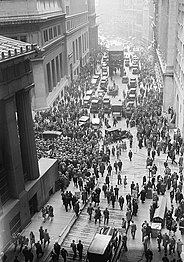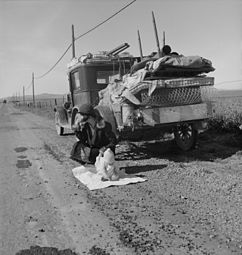United States
![]()
U.S. , USA and United States of America are redirections to this article. For other meanings, see the definitions of US, Usa, United States of America and United States.
Template:Infobox State/Maintenance/NAME-German
The United States of America (abbreviated USA), abbreviated United States (abbreviated U.S. , US) and often colloquially shortened to America, is a federal republic. It consists of 50 states, one federal district (the capital Washington, D.C.), five larger directly union-dependent territories and nine island territories. The 48 contiguous United States (often called the Lower 48) and Alaska are in North America and together form the Continental United States, while the state of Hawaii and smaller outlying territories are in the Pacific and Caribbean respectively. The country has a very high geographical and climatic diversity with a great variety of animal and plant species.
The United States of America is the third largest country in the world by area, 9.83 million square kilometres (after Russia and Canada), and by population, about 331.4 million (after China and India). The largest city by population is New York City, significant metropolitan areas are Los Angeles, Chicago, Dallas, Houston, Philadelphia, Washington, Miami, Atlanta, Boston and San Francisco, each with over 5 million inhabitants. The degree of urbanisation is 82.46 per cent (as of 2019).
Popular national myths of the United States state that the US is one of the most ethnically multicultural countries; however, empirical studies show that the US is only average in global comparisons of national ethnic and cultural diversity. Unlike 32 states, there is no legal official language at the federal level, but English prevails as the de facto official language. In the southwest and in Miami, Spanish is also widely spoken. In total, more than 350 languages were in domestic use in 2015, 150 of which were indigenous. The largest of these were those of the Yupik in Alaska, the Dakota from the Sioux language family and the various Apache languages in use, then Keres, the language of the Pueblo Indians, and Cherokee.
Palaeoindians migrated from Asia to the North American mainland of what is now the United States (Buttermilk Creek Complex) more than 13,000 years ago, having settled Alaska, now part of the USA, several millennia earlier. European colonisation began around 1600, mainly from England, but in protracted conflict with France. The United States emerged from the 13 colonies on the Atlantic coast. Disputes between Britain and the American colonies led to the American Revolution. On 4 July 1776, delegates from the 13 colonies adopted the United States Declaration of Independence, thus establishing the United States of America. The American War of Independence, which ended with the recognition of independence, was the first successful war of independence against a European colonial power. The present Constitution was adopted on 17 September 1787. So far, 27 amendments have been added. The first ten amendments, collectively known as the Bill of Rights, were ratified in 1791 and guarantee a variety of inalienable rights.
Driven by the doctrine of Manifest Destiny, the United States began an expansion across North America that spanned the 19th century. This included the forcible expulsion of indigenous Indian tribes, the acquisition of new territories, including in the Mexican-American War, and the creation of new states. The American Civil War led to the end of legal slavery in the United States in 1865. By the end of the 19th century, the state had expanded to the Pacific Ocean and its economy became the largest in the world. The Spanish-American War and the First World War confirmed the role of the United States as a global military power. The USA emerged from the Second World War as a superpower and the first country with nuclear weapons, and became one of five permanent members of the United Nations Security Council. After the end of the Cold War and the collapse of the Soviet Union, the USA is the only remaining superpower. It is a founding member of the United Nations, the Organisation of American States (OAS) and many other international organisations. Their political and cultural influence is great worldwide.
The United States is an industrialised country and the largest economy with a gross domestic product of US$22.4 trillion in 2019, which represented 25% of nominal or 17% of purchasing power-adjusted global economic output. The country had the eighth highest per capita income in 2016. According to the World Bank, income distribution in the United States is one of the most unequal among OECD countries. The country's economic performance is favoured by its abundance of natural resources, well-developed infrastructure and high average productivity. Although the economic structure is commonly considered post-industrial, the country remains one of the world's largest producers of goods. The US was responsible for 36% of global military spending in 2016, ranking first, followed by China with 13% and Russia with 4.1%. The state of emergency declared in the wake of the terrorist attacks on 11 September 2001 has been in force since 2001.
Geography
→ Main article: Geography of the United States
Boundaries and expansion
The United States shares a border with Canada that totals 8,895 kilometres (with approximately 2,477 kilometres stretching between Alaska and Canada), and one with Mexico that is 3,326 kilometres long. The total length of US land borders is 12,221 kilometres. The coastline of the Atlantic, Pacific and Gulf of Mexico totals 19,924 kilometres.
The state covers a land area of 9,161,924 km², plus 664,706 km² of water areas, resulting in a national territory of 9,826,630 km².
The north-south extension between the Canadian and Mexican borders is about 2,500 kilometres, and the extension between the Atlantic and Pacific oceans is about 4,500 kilometres. The main part of the country lies roughly between latitude 24° and 49° north and longitude 68° and 125° west and is divided into four time zones (see Time Zones in the United States).
The northernmost city in the USA is Utqiaġvik in Alaska, the southernmost place is Hawaiian Ocean View in Hawaii.
Geology and landscape structure
The area is clearly structured. Thus, mountain ranges such as the volcanic Cascade range, the folded mountains of the Rocky Mountains and the Appalachians stretch from north to south. While extensive forests exist on their weather side, vast arid areas with desert or grasslands (prairies) extend in their lee. The river systems of the United States, such as those of the Mississippi and Missouri, allowed for dense settlement early on, while the surrounding arid regions remain sparsely populated to this day.
The highest mountain in the United States is Denali in Alaska at 6190 m, the lowest point is the Badwater depression in Death Valley at 85.5 m below sea level. Denali and Badwater are also the highest and lowest points of the North American continent, respectively.
Climate
→ Main article: Climate of the United States
The most important factor influencing the climate is the polar jet stream (polar front jet stream), which brings extensive low-pressure areas from the North Pacific. When the lows combine with those from the Atlantic coast, they bring heavy snowfalls in winter as Nor'easters. With no mountain range running west-eastwards, winter storms often bring large amounts of snow far to the south, while in summer the heat reaches far northwards into Canada.
The areas between the mountain ranges have correspondingly high temperature extremes, plus more or less drought, which increases towards the south and west. The Pacific coast, on the other hand, is a very rainy, often foggy area in the north. The area around the Gulf of Mexico is already subtropical with high temperatures in summer and often high humidity. In addition, the area is frequently hit by tropical cyclones.
Alaska has an arctic climate and its mountains are the highest in the United States (Denali, 6190 metres). Hawaii, on the other hand, whose Mauna Kea is 4205 metres high, has a tropical climate.
Flora and fauna
See also: National Parks in the United States
The areas on the east coast up to the Great Lakes were very heavily forested until the 19th century, the west coast in the temperate rainforest area of sometimes extremely tall trees with growth heights of over 100 metres. Only a few of these areas remain, such as the redwoods or the Hoh rainforest. Large areas have been converted to farmland or cultivated, and the majority is now commercial forest. The biodiversity of the drier grasslands has also been greatly reduced in the course of agricultural use. However, protected areas and measures have led to many of the more than 17,000 vascular plant species being saved. Hawaii alone has 1,800 flowering plants (angiosperms), many of which are endemic.
Around 400 mammal, 750 bird and 500 reptile and amphibian species as well as well over 90,000 insect species make up part of the fauna, with a separate law protecting endangered species since 1973. 58 national parks in the still large remaining wilderness regions and several hundred other protected areas predominantly show a great diversity of species, which stands in clear contrast to the widespread monocultures. Mainly due to the large number of endemic species, genera andfamilies, the great species diversity or biodiversity and the diverse ecosystems, the USA is one of the megadiversity countries of this earth. Only the Mediterranean hardwood vegetation of the flora province of California is listed internationally as a biodiversity hotspot due to the great threat to nature.
Nature and environmental protection
Historically, some important developments in nature conservation stem from the history of the United States: The national park idea and with it Yellowstone National Park, the world's first large-scale protected area of this kind, originated in the United States. As a national authority, the Senate established the National Fish and Wildlife Foundation (NFWF) to look after all national protected areas. On the one hand, US NGOs such as Conservation International are world leaders in nature and resource conservation. On the other hand, the United States is one of the few countries that has not signed the most important international agreement, the Convention on Biological Diversity.
Metropolitan areas
See also: List of cities in the United States and List of metropolitan areas in the United States.
82.26 per cent of Americans lived in urban areas in 2018. In 2016, 307 places had more than 100,000 inhabitants and there were 54 metropolitan areas with more than one million inhabitants (with only ten cities). The largest metropolitan areas in 2016 were New York City (20.1 million), Los Angeles (13.3 million), Chicago (9.5 million), Dallas (7.2 million), Houston (6.7 million), Washington, D.C. (6.1 million) and Philadelphia (6 million). The main metropolitan areas are between New York and the Great Lakes, in California and Arizona, as well as in Texas and to a lesser extent in Florida. With 33 inhabitants per square kilometre, the USA is a rather sparsely populated country. The east of the country is much more densely populated than the west.
| Top 10 cities and metropolitan regions (as of 2016) | ||||||
| Rank | City | Inhabitants | Rank | Metropolitan Region | Inhabitants | |
| 01 | New York City | 08.537.673 | 01 | New York City-Newark-Jersey City | 20.153.634 | |
| 02 | Los Angeles | 03.976.322 | 02 | Los Angeles-Long Beach-Anaheim | 13.310.447 | |
| 03 | Chicago | 02.704.958 | 03 | Chicago-Naperville-Elgin | 09.512.999 | |
| 04 | Houston | 02.303.482 | 04 | Dallas-Fort Worth-Arlington | 07.233.323 | |
| 05 | Phoenix | 01.615.017 | 05 | Houston-The Woodlands-Sugar Land | 06.772.470 | |
| 06 | Philadelphia | 01.567.872 | 06 | Washington, D.C. -Arlington-Alexandria | 06.131.977 | |
| 07 | San Antonio | 01.492.510 | 07 | Philadelphia-Camden-Wilmington | 06.070.500 | |
| 08 | San Diego | 01.406.630 | 08 | Miami-Fort Lauderdale-Palm Beach | 06.066.387 | |
| 09 | Dallas | 01.317.929 | 09 | Atlanta-Sandy Springs-Roswell | 05.789.700 | |
| 10 | San José | 01.025.350 | 10 | Boston-Cambridge-Newton | 04.794.447 | |
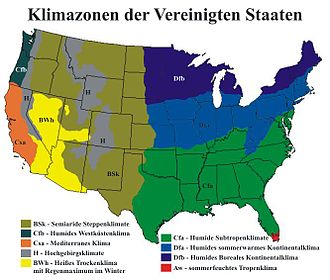
Climates of the United States
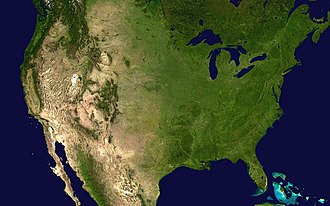
Satellite image of the 48 central states of the United States (excluding Alaska and Hawaii) and adjacent areas.

Population density of the United States
Population
See also: Demography of the United States
Ethnic groups and immigrant groups
| Population groups | |
| (According to Census estimate from July 2019) | |
| White | 60,4 % |
| Hispanics and Latinos | 18,3 % |
| African American | 13,4 % |
| Asian Americans | 5,9 % |
| Multiethnic Americans | 2,7 % |
| North American Indians and Alaska Natives | 1,3 % |
| Native Hawaiians and Americans from Oceania | 0,2 % |
The original inhabitants of the country, the Native Americans or American Indians, now make up only about one percent of the population. Only in Alaska do they make up a double-digit percentage of the population. Other focal points are Oklahoma, California, Arizona, New Mexico and South Dakota. They do not form a unity; culture, language and religion differ from tribe to tribe. There are a total of 562 recognised tribes, plus 245 groups that are not currently recognised as tribes.
The first colonial immigrants to the continent populated by Indians were Europeans, initially primarily of Spanish, French and English origin. With them came slaves from the 17th century onwards, mostly from West Africa. From the middle of the 18th century and increasingly towards the middle of the 19th century, Europeans of German-speaking and Irish origin followed. Later, immigrants from other regions of Europe joined them, especially Italians, Scandinavians and Eastern Europeans, including Eastern European Jews. In the second half of the 19th century, there was immigration from East Asia and the Near East. In addition to economic motives, religious or political persecution also played a role for many.
Americans with European ancestry now make up 72 per cent of the total population. African Americans make up just over 13 percent. They live mainly in the South and in the large industrial cities of the North. Asian immigrants, largely from China, Japan, Korea, India and the Philippines, make up about five percent. During the last census, more than 50 million people declared German origin. This makes German Americans the largest population group in the United States.
Especially in the southwest of the United States and in Florida, there is a high proportion of the population with Latin American origins, who are referred to there as "Hispanics" or "Latinos". Many of them strongly adhere to their culture and language. Their share in the US has grown steadily in recent decades (to 17 per cent by 2013) as many Latin Americans flee economic hardship to the North. They often come as illegal immigrants.
There are large differences in the social structure between white and black populations. Black people have on average a lower income, a shorter life expectancy and a poorer education. They are both more likely to be victims and perpetrators in a homicide and more likely to be sentenced to death. The causes of this and possible ways to remedy the problem are controversial. Not only in the southern states are neighbourhoods and non-public institutions - such as churches or private organisations - often de facto segregated by ethnicity, even if formal segregation is now illegal and frowned upon.
Population development
Population numbers have grown continuously since 1610. Forecasts predict a further increase until 2050: By 2025, according to a United Nations forecast, the population will grow to 358 million inhabitants, and by 2050, more than 408 million people will live in the country.
Since 1790, the Constitution has provided for a decennial census, the so-called United StatesCensus. Immigrants have played a significant role in the population increase. For example, since the Immigration and Naturalisation Services Act of 1965, the number of foreign-born people has increased fivefold, from 9.6 million in 1970 to around 49.8 million in 2017. In the 1990s, the number of immigrants rose to one million per year. In 2000, the proportion of foreign-born people was 11.1 per cent of the total population. By 2017, it had risen to 15.3 per cent. At the same time, nearly 3 million Americans lived abroad. Most of these were in Mexico (900,000), Canada (310,000), the United Kingdom (190,000), Germany (140,000) and Australia (120,000).
The birth rate per woman was 1.87 children in 2016. The birth rate of Hispanics and Latinos is higher than that of the rest of the population. There were 12.5 births and 8.2 deaths per 1000 inhabitants in 2016. In the same year, the median age was 37.9 years. In 2016, the population grew by 0.81%, or about 3 million. Of the countries in the industrialised world, the USA has one of the youngest and fastest growing populations.
| Census | ||||||||||||||||||||||||||||||||||||||||||||||||||||||||||||||||||
|
|
| ||||||||||||||||||||||||||||||||||||||||||||||||||||||||||||||||
Languages
→ Main article: Languages in the United States
| Languages spoken at home in the United States by number of speakers (2013) | |
| English (only) | 231.1 million |
| Spanish, incl. Creole languages | 37.4 million |
| Chinese | 2.9 million |
| Tagalog (Philippines) | 1.6 million |
| Vietnamese | 1.4 million |
| French, incl. Cajun | 1.3 million |
| Korean | 1.1 million |
| German | 1.1 million |
The most widely spoken language in the United States is American English. In addition, many Native American and Hawaiian languages and the languages of immigrants are spoken. The last census identified a total of 382 languages, 169 of which are Native American. The latter, however, have only about 400,000 speakers, about half of them Navajo. In Apache County in Arizona alone there were 37,000, in McKinley County in New Mexico 33,000. 227 million inhabitants speak only English, all other languages together account for more than 60 million speakers. The proportion of Spanish speakers is particularly high, although many immigrants speak only their Spanish mother tongue and sometimes inhabit their own neighbourhoods in cities (for example East Los Angeles or Union City). In California, their share is around 30 %, but many, especially the younger ones, are bilingual. Some 30 to 40 million live in the United States, not a few illegally under alien law. While there were many newspapers in German in the 19th century, Spanish is the second most common language in which newspapers are published today.
Besides German (→ German Americans), French, Chinese, Korean, Vietnamese and Tagalog are also common. Especially in cases where mixing with the rest of the population is low, the language brought with them is retained in subsequent generations (for example, by the Amish in Pennsylvania, Ohio, Indiana and Illinois).
Despite certain advantages of a common language, the United States has not established a single official language. However, all official documents are written in English. Thirty-two states have English as their official language; individual states and territories define themselves as bi-, tri- or multilingual, such as Hawaii, Alaska, Guam or Puerto Rico. Increasingly, documents and signage are translated into Spanish, but this phenomenon remains mostly regional. Just under 18% of Americans did not speak English at home in 2006, while 10% reported Spanish as their first language in the 2000 census.
In 1847, a law allowed French lessons in Louisiana, in 1849, the Californian constitution recognised Spanish. With the War of Secession, the rights of the Francophones disappeared, in 1868 it was recommended that Indians be taught in English, and in 1896 this was also to apply to Hawaii. From 1879, Californian laws were published only in English, and during the First World War the use of German was restricted. Individual states, such as Virginia in 1981 and California in 1986, declared English the official language.
On 8 May 2007, a resolution was presented to the Senate to declare English the "national language". This plan was rejected.
Religion
See also: Religious Freedom in the United States, Jews in the United States and African American Religion in the United States.
| Religious groups | |
| (According to Pew Research Center, 2019) | |
| Protestants | 43 % |
| Non-denominational | 26 % |
| Catholics | 20 % |
| Mormons | 2 % |
| Jews | 2 % |
| Muslims | 1 % |
| Hindu | 1 % |
| Buddhists | 1 % |
| Other | 3 % |
| Not specified | 2 % |
The government does not keep a register of residents' religious status. The United States Census Bureau is not allowed to ask questions about religious affiliation itself, but it publishes the results of other surveys. In a 2014 survey by the Pew Research Center, about 25.4 % of the population identified themselves as evangelical Protestants, 20.8 % as Roman Catholics, 14.7 % as mainline Protestants, and 6.5 % belong to traditional black Protestant churches. Among the smaller Christian churches, 1.6% are Mormons and 0.8% are Jehovah's Witnesses, 0.5% were members of an Orthodox church. Non-Christian religious communities include 1.9 % Jews, 0.9 % Muslims and 0.7 % Buddhists. 22.8 % of the respondents did not declare any religious conviction, of which 3.1 % were explicitly atheists and 4.0 % agnostics.
In 2014, around 70.6% of the population in the USA were Christians and 5.9% were adherents of non-Christian religions. In a survey conducted in 2008, 82% of US Americans said religion was important or very important in their lives (55% very important). Of these, 65% of women said religion was very important in their lives, compared to 44% of men. According to this survey, 54% of the US population prays at least once a day, a figure that compares to 10% in France, 19% in Germany, 32% in Poland, 42% in Turkey and 69% in Brazil.
According to a study by the Gallup Institute, about 73 % of the population were Christians in 2016 (48.9 % Protestants of the various streams, 23 % Catholics and 1.8 % Mormons). Judaism remains the largest non-Christian religion in the United States, accounting for 2.1% of the population. 0.8% of the population is Muslim, and 2.5% belongs to other religions. 18.2 % of the respondents belonged to the non-denominational/atheist/agnostic group.
The regional distribution of denominations varies; while the majority of Catholics live in New England, the southern states have an evangelical character. The centre of the Mormons is in Utah and the surrounding states (Nevada, Idaho); especially in the south of the USA on the border with Mexico and due to Cuban emigration in the greater Miami area live predominantly Catholic Latinos. The centres of the Jewish population are metropolises such as New York and the surrounding area, Boston, Los Angeles, San Francisco and southeast Florida.
Social structure
According to sociologists such as Dennis Gilbert of Hamilton College, society in 1998 consisted of six social classesSource? with a determinable proportion of the total population: an upper class (about 1%) consisting of the most prominent, wealthy and powerful citizens; an upper middle class (about 15%) consisting of highly educated professionals such as doctors, professors, lawyers; a lower middle class (about 32%) consisting of well-educated professionals such as school teachers and craftsmen; a working class (about 32%) consisting of industrial workers and blue-collar workers; and finally a lower class (about 20%) divided into two groups. Its upper group consists of the working poor, who work in low-paid jobs without insurance or only part-time. The lower group does not work and is dependent on public welfare, which is very meagre in the United States (unemployed poor).
It is striking that members of these lower classes mostly live in certain neighbourhoods of the big cities, while the middle class in the 1960s to 1980s moved to the suburbs, which are beyond the borders of the big cities but still within the metropolitan regions. The proportion of poor among blacks and Hispanics is disproportionately high (about 30 %).
Between 1977 and 1999, incomes in the richest one-hundredth of the population rose by 115 % after tax deductions. Real wages for 60% of workers fell by 20% during that time. The number of Americans living in poverty increased by 1.7 million people in 2002 to a total of 34.6 million. The number of people living in extreme poverty (less than half the official poverty line), increased from 13.4 million in 2001 to 14.1 million in 2002. Poverty rates, as well as child poverty rates, vary greatly between ethnic groups. In 2009, 7.1 million (18.7 per cent) of people aged 65 and over were affected by the NAS definition of poverty. In 2013, 47 million people in 23 million households in the US received government food stamps, representing 20 % of US households. 90 % of US Americans receive an income of $30,000? An analysis of Census data from 2010 also revealed that around 1.5 million households have to live with virtually no money at all. They have incomes of less than 2 dollars per person per day, but some receive food vouchers or in-kind allocations and some live in publicly paid housing. A significant proportion, however, is completely cut off from the cash economy.
Even households with incomes well above the federal poverty line can often be addressed as working poor due to the high cost of living in their region, if and to the extent that they are unable to build up reserves or savings. Around 25 % of households with middle-class incomes between 40 and 55 years of age had net assets below $17,500 at the end of 2014 (not taking into account any owner-occupied housing and pension entitlements).
Overall, the gap between the poorest and the top of society has widened dramatically in recent years: The upper class, i.e. the top 1% of the population, owned 37.1% of the total wealth of the United States in 2009, according to an estimate by the Levy Economics Institute of Bard College (USA), which is an increase of 3.7% compared to 2001. The bottom 80% of the population, on the other hand, owns only 12.3% of the total wealth, which is a decrease of 3.3% for the same period.
In 2017, according to Forbes, there were 585 billionaires in the United States (27% of all billionaires in the world), making the United States the country with the most billionaires in the world. 7 of the 10 richest people in the world were Americans in 2018. The richest man in America and the world was Jeff Bezos, whose $112 billion fortune was greater than Kenya's economic output (as of February 2018). In 2005, the richest one percent of the American population earned an income of $524 billion, which was 37% higher than that of the poorest 20% of the population ($383 billion). Thus, the average wealth of all US families was $692,000; the more meaningful median wealth was $97,300.
Immigration policy
→ Main article: Immigration to the United States
| Most frequent countries of origin of migrants by country of birth 2015 | ||
| Rank | Country | Number of migrants |
| 1 | Mexico | 12.050.031 |
| 2 | China People's Republic of | 2.103.551 |
| 3 | India | 1.969.286 |
| 4 | Philippines | 1.896.031 |
| 5 | Puerto Rico | 1.744.402 |
| 6 | Vietnam | 1.302.870 |
| 7 | El Salvador | 1.276.489 |
| 8 | Cuba | 1.131.284 |
| 9 | Korea Sud | 1.119.578 |
| 10 | Dominican Republic | 940.874 |
From 1951 to 1960, 2.5 million people immigrated annually, between 1971 and 1980 a total of 4.5 million, and in the 1990s a total of over 10 million. In 2003, 463,204 people were granted US citizenship, and in 1997 to 2003 the average was about 634,000. In 2015, there were 46,627,102 foreign-born residents, accounting for 14.5% of the population, making the US the world's largest migrant population. A large proportion of foreign-born residents were of Latin American origin, mainly from Mexico and Central America. In recent years, migration from Asian countries such as China, India, Vietnam, South Korea and the Philippines has increased.
As early as 1790, the United States regulated immigration with the Naturalisation Act, a law that was intended to promote immigration from Europe, but excluded blacks and "freemen" and required "good moral character". In 1882, Chinese were explicitly excluded with the Chinese Exclusion Act, a regulation that was repeated in 1943 in a slightly modified form. In 1891, an Immigration Commission was established that set annual country quotas.
In 1921, the Emergency Quota Act regulated immigration for the first time in a way that gave preference to Northern and Western Europeans by freezing their share of the population according to the census - a trend that was solidified with the Immigration Act of 1924. Immigration policy was particularly restrictive towards Asians in the early 20th century.
It was not until 1965 that the time of application and the region of the world were taken into account; family reunification cases were added. Since 1978, a uniform quota has applied to immigration to the United States. In 1970, 62 % of foreign-born Americans were still Europeans, but by 2000 this share had fallen to 15 %.
Hispanics are the largest minority in the United States. In 2000, there were 35.2 million Hispanics living in the US; in 2013, there were 54 million, resulting in a percentage increase of 54 per cent. Of the 54 million, 34.5 million were of Mexican origin. Estimates of illegal immigrants vary from 7 to 20 million, with most estimating their number at around 12 million. Hundreds of thousands cross the southern border illegally each year, including tens of thousands of minors, some of them unaccompanied. The state commission for human rights in Mexico stated that in 2007 alone, 500 illegal immigrants died trying to cross the border - often by dying of thirst. Between 1995 and 2007, there were 4,700 Mexicans.
To combat illegal immigration from Mexico, President Bush signed the Secure Fence Act in October 2006, which provided for the construction of 1,100 kilometres of border fortifications. In addition, the support of illegal immigrants became a punishable offence.
As early as 1954, the government had attempted to deport 1.2 million Hispanics with Operation Wetback - the expletive "wetback" being derived from Mexicans who had swum across the Rio Grande. In 1965, Mexican immigration was restricted, and the Immigration Reform and Control Act (IRCA) of 1986 legalised illegal immigrants for the first time.
In 2015, approximately 627,000 German-born people lived in the United States.
Crime and justice
→ Main article: United States prison system
According to FBI Uniform Crime Reporting, the crime rate in the United States has been declining since the early 1990s. Violent crime peaked in 1991 with 758 cases per 100,000 population. In 2000, it was 507, in 2010 it was 405, and in 2018, 381 cases were recorded.
For comparisons of the propensity to violence over long periods of time and large spatial distances, the rate of homicides is used as an index. In 2017, the United States had 5.3 cases per 100,000 inhabitants. A peak was in 1991 with 9.7 cases. Today's rate of 5.3 is far higher than Germany's rate of one. The average in Europe is 3 cases per 100,000 inhabitants, the global average is 6.1. East Asian countries average 0.6, Singapore only 0.2 cases per 100,000 inhabitants.
The United States has the largest prison population in the world, both in absolute terms and relative to the population. In 2008, over 2.4% of the United States population was either in prison (2.3 million) or on probation (4.3 million) or parole (0.828 million). By 2011, the prison population had risen to over 2.4 million. This makes the United States by far the world's leader in the ratio of prison inmates to population. The crime rate, on the other hand, initially remained constant and later even decreased.
During the 1960s, the prison population had been falling by about one per cent a year, reaching a low of 380,000 in 1975. Since about 1980, the number increased significantly, so that in 1985 there were already 740,000 and by the end of 1998 there were even two million. Two thirds of the prisoners come from households with less than half of the income defined as the poverty threshold.
In 2000, 133,610 persons under the age of 18 were housed in detention centres and juvenile detention centres in the United States. The age of criminal responsibility begins much earlier in the United States than in Germany. In many states, a person as young as 7 years old can be held responsible for breaking a criminal law, in most others this is the case from the age of 11. In 2005, 1,403,555 under-18s were arrested. In 2003, it was possible in 33 states to place mentally ill children and adolescents in custody even if they had not violated the criminal law.
African Americans make up about 13 per cent of the total population, but account for 38 per cent of the prison population. Half of all murders in the USA and about one third of all rapes are committed by African Americans. A disproportionate share of Blacks and Latinos can be seen in the number of armed assailants. For example, between January and June 2008, a total of 98 per cent of all assailants armed with firearms in New York City were either Black or Hispanic. In March 2015, 16 per cent of inmates in American prisons were Mexican nationals, and another 7.5 per cent of inmates had a citizenship other than American or Mexican.
In contrast to almost all other states in the Western world, the death penalty is carried out in numerous states in the United States, which has been controversial for years, including in the United States itself. A total of 19 states have abolished the death penalty, most recently Nebraska in May 2015. In the remaining states, death sentences continue to be carried out, even on people with mental disabilities and those who were minors at the time of the charged offence. There are more than 3,200 men and women on death row, almost 42% of whom are African American.
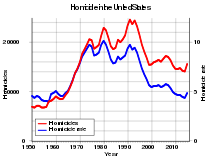
Murder rate since 1950

Cases of violent crime since 1960. Translations: Aggravated Assault, Rape, Robbery, Murder and Manslaughter.

The distribution of the poorest households in the United States
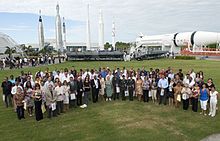
Naturalisation ceremony at Kennedy Space Center
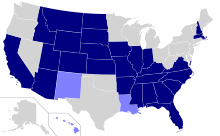
English is the official language in 32 states, Hawaii additionally accepts Hawaiian and since 2014 Alaska also accepts the state's 20 indigenous languages. Louisiana also translates into French, New Mexico also into Spanish. In several states, courts have yet to decide on this.
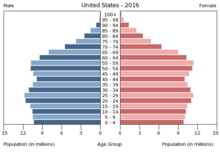
Population pyramid of the USA 2016
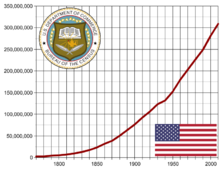
Population development in the United States
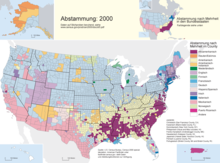
Descent groups with highest population share in the counties
History
→ Main article: History of the United States
Early history
In Alaska, the oldest confirmed human traces date back 12,000 to 14,000 years. The Clovis culture was long considered the oldest culture, but the finds in the Paisley Caves, which predate the Clovis finds by about a millennium, showed that North America was inhabited earlier. The oldest human remains are considered to be the relics of the Buhl woman from Idaho, who is over 10,500 years old. This early phase was followed by the Archaic period.
Between 4000 and 1000 BC, the use of pottery, agriculture and various forms of graduated sedentarism developed. Hunting techniques were greatly improved by atlatl and later by the bow and arrow. Population densities occurred in North America around the Great Lakes, on the Pacific coast around Vancouver Island (Canada), on the Mississippi River and in many places on the Atlantic coast as well as in the Southwest.
Complex communities developed in the catchment area of the Adena and Mississippi cultures, but they perished shortly before the arrival of the first Europeans. They radiated far into the north and west. In the southwest, adobe settlements with up to 500 rooms developed. This Pueblo culture went back to the Basketmakers, who were already cultivating maize. Around the Great Lakes, fortified large villages and permanent confederations developed. These groups, similar to those in the West, practised maize and squash cultivation as well as extensive long-distance trade - for example, in copper and certain types of rock that were important for hunting weapons and jewellery - which can be traced in British Columbia (Canada) from 8000 BC.
Impact of colonisation on the indigenous people
Introduced diseases decimated the population to an extent that was difficult to measure. Many groups disappeared due to introduced diseases without any Europeans even having seen them. According to the anthropologist Alfred Kroeber, the population north of the Rio Grande was estimated at only one million people. These estimates were readily seized upon, as it perpetuated the myth that the whites had conquered a largely deserted continent. The Smithsonian Institute, known as rather cautious, tripled its estimate for North America to three million people. The extent to which the discussion has been set in motion is shown by the thesis that the huge herds of buffalo were grazing animals of the Indians, according to which the size of the herds did not represent a natural equilibrium but was based on overproliferation after the sharp decline in the human population.
Despite the impact of the epidemics, which cannot be overestimated - Hernando de Soto already brought devastating diseases to the area between Mississippi and Florida, and in 1775 a smallpox epidemic devastated the Pacific coast - the effects of the wars should not be underestimated. The most costly wars in the East were probably the Tarrantine War (1607-1615), the two Powhatan Wars (1608-1614 and 1644-1646), the Pequot (1637), King Philip's War (1675-1676), the French and Indian Wars (1689-1697, 1702-1713, 1744-1748, 1754-1763) and the three Seminole Wars (1817-1818, 1835-1842 and 1855-1858). In addition, there were the inter-tribal uprisings led by Chiefs Pontiac (1763-1766) and Tecumseh (c. 1810-1813). The French were in the Beaver Wars from about 1640 to 1701, then in four wars with the Natchez (1716-1729), the Dutch in the Wappinger War and the Esopus Wars (1659-1660 and 1663-1664), the Spanish in 1680 against the Pueblos in the Southwest, and in numerous other battles. In the western United States, it was mainly the battles under Cochise (1861-1874), the Sioux War (1862) and the Lakota War (1866-1867), or that of the Apaches under Geronimo (until 1886) that became famous. Individual battles, such as the Little Bighorn or the massacre at Wounded Knee (1890), also became famous.
The fur trade triggered completely different long-distance changes. On the one hand, this trade had an effect on the tribes that acted as hunters and suppliers, but also on their near and distant neighbours, be it through the acquisition of weapons and related shifts in power, be it through the development of trade monopolies of the tribes encamped near the trading bases (forts), be it through the triggering of extensive migrations of peoples, as by the Iroquois. The position of the leading groups also became dependent on the fur trade.
From the first colonisation phase to independence
The first European settlement in what is now the US was founded by the Spanish in St Augustine, Florida in 1565. The first permanent English colony was Jamestown in Virginia, which came into being in 1607, shortly after Frenchmen had founded a first colony in what later became Canada. The arrival of the emigrant ship "Mayflower" in Plymouth Colony (later merged with Massachusetts Bay Colony to form Massachusetts) in 1620 is considered an important symbolic date. Swedish colonies on the Delaware and Dutch settlements around New York (Nieuw Amsterdam) were taken over by England.
Apart from the British, only the French and the Spanish were able to achieve lasting political importance. For Spain, its colony of Florida had only a secondary function compared to its large possessions in Central and South America. France, on the other hand, limited its settlement to its colonial core area on the Saint Lawrence River (New France), while still retaining a strong economic interest in its remaining territories between the Mississippi and the thirteen colonies of the British. To cover the fur trade routes, these territories, otherwise not settled by Europeans, were protected by a system of forts and alliances. The British colonies, on the other hand, were under high immigration pressure, which led to a constant westward shift of the settlement boundary. This happened both according to state plan (by a single colony) and in wild colonisation against British and Indian resistance.
In the French and Indian War of 1754 to 1763, opposing interests clashed. The conflict was a side show in the global conflict between Great Britain and France, the Seven Years' War. Most Indian tribes fought on the side of the French.
In the peace treaty of 1763, the entire French territories east of the Mississippi (except New Orleans) as well as the French-populated areas around Québec and Montreal fell to the British side. Spain had sided with its French kin during the war. After the war, it had to cede Florida to the British and received the previously French territory west of the Mississippi as compensation.
The government in London demanded that the colonists should bear a higher share of the costs of the post-war order, at the same time, in order to avoid conflicts, it tried to prevent the wild settlement to the west. The colonies resisted taxation, arguing that it violated English law, according to which there could be "no taxation without political representation". In this way, the settlers effectively declared the British Parliament not entitled to issue instructions (but not the Crown). Moreover, although the mother country demanded higher taxation, it blocked the development of economic policy instruments such as its own currency issue, which would have been necessary to strengthen the colonies financially. Parliament acted in this way because it did not want to encourage American state-building, but in doing so it created a contradiction. In addition, various taxes perceived as unjust, such as the Stamp Act or on sugar and tea, embittered the colonists. There were boycotts and acts of resistance, such as the Boston Tea Party, which reached its first climax in the Boston Massacre. London eventually stationed more soldiers, which further fuelled separatist tendencies in the thirteen colonies.
An attempt by British soldiers to excavate a colonial armoury finally triggered the War of Independence in 1775. A Continental Congress met and gave the military supreme command to George Washington. On 4 July 1776, 13 colonies proclaimed the Declaration of Independence. Not least through the military support of France, the Americans forced the British Empire to recognise their state sovereignty in the Peace of Paris in 1783.
The territory of the now independent colonies included the area of the following 16 of the now 50 states of the United States: New Hampshire, Massachusetts, Maine, RhodeIsland, Connecticut, New York, Vermont, New Jersey, Pennsylvania, Delaware, Maryland, Virginia, West Virginia, North Carolina, South Carolina and Georgia.
From independence to civil war
The Articles of Confederation adopted in 1777 and ratified in 1781 had proved insufficient to ensure the survival of the young confederation. Therefore, the second Constitution of the United States was signed in Philadelphia in 1787. It is the second oldest republican state constitution still in force - only the Constitution of the Republic of San Marino from 1600 is older. The first president of the United States was George Washington, the general of the War of Independence, who was elected unanimously by a large consensus in 1789.
The development of the new state was essentially determined by two factors in the first decades: on the one hand, by rapid territorial growth and further land grabbing at the expense of the Indians, and on the other hand, by the dispute over slavery, which later determined the struggle for the civil rights of the descendants of the former slaves. At the time of the War of Independence, about two million whites and 500,000 enslaved blacks lived in the thirteen colonies.
During the European Coalition Wars, the Louisiana Territory (not to be confused with today's state of Louisiana) had fallen back to France from Spain. However, Napoleon refrained from re-establishing the French overseas empire for financial reasons. Instead, in 1803 he sold the entire area between the Mississippi and the Rocky Mountains to the USA for 15 million dollars, which doubled its territory in one fell swoop. In the same year, the first states from the Northwest Territory between the Ohio River and the Great Lakes joined the Union, followed by parts of Louisiana from 1813.
The United States initially pursued a course of neutrality towards France and Great Britain. In 1812, however, the British-American War broke out over Canada, which remained British. The conflict ended with a compromise, so that the border demarcation between the United States and Canada was from then on completed in the east. Early American foreign policy was otherwise shaped by President James Monroe's Monroe Doctrine, proclaimed in 1823. This stated that the European powers should stay away from the American continent, while at the same time the United States should not interfere in the affairs of other states.
Indian policy became more aggressive from 1820: the Indian Removal Act and the subsequent Trail of Tears began decades of forcible land seizure and settlement, leading to renewed fighting. Indians were deported to reservations. One of the few victories for the Indians was the Battle of Little Bighorn in 1876, but it remained politically meaningless. The Indian Wars ended in 1890 with the massacre at Wounded Knee. In 1900, less than a quarter of a million Indians were alive, contributed not only by war but also by epidemics. It was not until 1924 that the Indians received full civil rights.
The second central issue in American politics until 1865 was the slavery question. The importation of more slaves from overseas was prohibited by law in 1808. However, due to the widespread circumvention of this ban by slave traders and natural population growth, the number of slaves had nevertheless increased to about four million by 1860. The slavery issue increasingly divided the Southern from the Northern states, as industrialisation took hold in the Northern states and the number of slaves slowly declined, while the owners of the vast rice and cotton plantations in the Southern states continued to practice slavery on a growing scale. New states from the acquired territories were only admitted in pairs so as not to endanger the unstable balance. Slavery was in contradiction to the Declaration of Independence, according to which "all men are created equal". Therefore, movements such as abolitionism, which demanded the abolition of slavery, gained strong support in the North. The war against Mexico (1846-1848) brought the United States a further gain of territory that constitutes today's Southwest. However, it also increased domestic tensions, as the Northern states partly saw it as a land grab in favour of the expansion of the slave states.
After Abraham Lincoln was elected US president in 1860 for the newly founded Republican Party, eleven southern states left the Union. This marked the beginning of the War of Secession (1861-1865). Initially, the constitutional question of whether the federal government had the right at all to decide on elementary substantive issues in the states was at the forefront. The Northern states emerged victorious from the Civil War and slavery was abolished by law. Blacks were formally granted full civil rights with the Civil Rights Act of 1866 and the 14th Amendment of 1868.
From the Civil War to the Great Depression
In 1890, the frontier was declared closed. This ended the era of the "Wild West". Immigration did not let up, so that between 1880 and 1910 a total of 18 million people were admitted. Industrialisation since the War of Secession led to the formation of large trusts that could influence politics through their economic power. Therefore, the Antitrust Act was passed in 1890, as a result of which several large corporations such as Standard Oil and the American Tobacco Company were unbundled from 1911.
As a result of the Spanish-American War of 1898, the United States extended its sphere of influence to the Philippines, Puerto Rico, Hawaii and Cuba. An interventionist policy was pursued by President Theodore Roosevelt (1901-1909), who claimed a hegemonic position of power over the Latin American states (Big Stick). In 1903, the United States separated Panama from Colombia in order to cede sovereignty over the Panama Canal to the newly formed state.
During the First World War, the United States remained formally neutral until 1917, but supported the Entente mainly through supplies. On 1 February 1917, Germany declared unrestricted submarine warfare as a countermeasure, whereupon the United States declared war on Germany on 6 April and introduced conscription on 5 June. After its victory over Russia, the German Reich sent the freed-up troops to the Western Front and organised a last futile offensive in the spring of 1918. The American troops arriving in France finally shifted the balance of power in favour of the Allies. After the military victory, President Woodrow Wilson (1913-1921) tried to establish a stable post-war order in Europe by making the right of self-determination of peoples and the formation of a League of Nations a maxim on the basis of his 14-point programme. This plan failed: On the one hand, the English and French refused to implement Wilson's plan in favour of a victorious peace vis-à-vis the German Empire; on the other hand, the US Senate refused to join the League of Nations, so that the now largest political power in the world was absent from this body and reverted to isolationism.
Due to the costly war and the subsequent reconstruction, the Europeans had become debtors of the United States. The outstanding economic role of the United States was particularly evident when the stock market crash in October 1929 (Black Thursday with price losses on the Dow Jones of up to 12.8 % in one day) was followed by the Great Depression. In the United States, this led to an internal crisis lasting years (Great Depression) with about 15 million unemployed and a population of about 125 million in 1932. Under President Franklin D. Roosevelt, far-reaching economic and social reforms were implemented with the New Deal. Among other things, the financial markets were regulated (Glass-Steagall Act) and the foundations of an American welfare state were created with the Social Security Act of 1935. In addition, numerous public construction projects such as roads, bridges, airports and dams were realised.
From the Second World War to the End of the Cold War
At the outbreak of the Second World War, the United States initially remained neutral, but provided massive support to Great Britain and the Soviet Union with capital and arms supplies under the Lend-Lease Act. Following the attack on Pearl Harbor by Japanese forces on 7 December 1941, they declared war on Japan and shortly afterwards received declarations of war from Germany and Italy. As in the First World War, the industrial potential of the United States was crucial to the Allies' victory. The surrender of the German Reich in May and the surrender of Japan in August 1945 ended the Second World War.
The US had made high gains with low casualties in the Second World War. Its total losses were 300,000 killed and 670,000 wounded, less than 0.5% of the population. The country was the only one to emerge from the war economically stronger, and at the end of the war it alone possessed a nuclear weapon of mass destruction. The USA had risen to become a superpower with a global presence.
The Bretton Woods system, founded as early as 1944, established the dollar as the international reserve and reserve currency with a gold standard. It corresponded to the American ideas of free world trade and open markets.
The United States was instrumental in the founding of the United Nations in San Francisco on 26 June 1945, which took place in agreement with the Soviet Union. Soon, however, a confrontation with the former wartime ally Stalin became apparent, which led to the Cold War. President Harry S. Truman pursued an anti-communist policy of containment, which found expression in the Truman Doctrine. In a departure from the isolationist Monroe Doctrine, it granted military and economic aid to all countries to preserve their independence. The United States supported Greece and Turkey and launched the Marshall Plan to stabilise Western Europe economically. The Cold War reached a first climax with the Berlin Blockade in 1948/49, to which the United States responded with the Berlin Airlift. In 1949, NATO was founded as a military alliance between the United States, Canada and Western Europe.
The nuclear arms race that now began between NATO and the Warsaw Pact, which provided both sides with a multiple "overkill capacity" from the 1960s onwards, and which was at the same time seen as a race between social systems, led to confrontations and proxy wars, such as the Korean War (1950-1953), the Cuban Missile Crisis (1962), in which the world only narrowly escaped a Third World War, or the Vietnam War. The Nuclear Non-Proliferation Treaty and the SALT negotiations (1968 and 1969) attempted to defuse the dangerous situation.
The Cold War, which was only not openly fought in the industrialised countries, led many Americans to regard communism as an enemy image. Domestically, this led to a climate of suspicion and control known as the "McCarthy era". The Republican Senator Joseph McCarthy distinguished himself in the Senate Committee on Un-American Activities (HUAC) by suspecting film-makers, politicians and military officers in particular of being communists and expecting denunciations. Those who refused to testify could expect to be banned from their profession. The hearings were often broadcast on television. When McCarthy finally suspected President Eisenhower, he was ousted by the Senate in 1954.
The Vietnam War, in which the United States intervened in 1964 after the Tonkin Incident, having sent military advisors before, turned into a military and moral fiasco that ended with the withdrawal of US troops in 1973. The credibility as a propagator of democratic values suffered here and also in other conflict hotspots with the support of numerous military dictators or the support of military coups, such as those of Mobutu in the Congo, then called "Zaire", or the military coups against the democratically elected governments of Guatemala (1954), Brazil (1964) and Chile (1973).
In addition to social and political movements, three assassination attempts in particular shook the nation and with it the world in the 1960s: the assassination of President John F. Kennedy (1963), the assassination of the preacher and civil rights activist Martin Luther King, who was the figurehead of the non-violent struggle for black rights (1968) - and in the same year the assassination of the Democratic presidential candidate Robert F. Kennedy, a younger brother of the assassinated president.
Blacks had been formally freed from slavery in 1865, but already in the course of the reconstruction of the war-ravaged South, the Southern states had passed laws that again restricted their civil rights (Jim Crow laws). Although they emphasised equal rights, they also provided for racial segregation. Only the Civil Rights Movement was able to eliminate the last formal inequalities. A very important step was the abolition of racial segregation in public institutions by the Supreme Court in 1954. However, school attendance by blacks had to be partly enforced with the help of the National Guard, as the governors of the southern states (especially George Wallace from Alabama) insisted on their state rights, which included segregation, until the end of the 1960s.
In 1964, under President Lyndon B. Johnson, who succeeded Kennedy in office after his assassination in 1963, was himself elected in 1964 and remained in office until 1969, the Civil Rights Act of 1964 was passed, declaring racial segregation illegal in the United States. In 1965, Johnson passed another law, the Voting Rights Act, which prohibited any discrimination against African Americans in elections. Finally, Congress passed the Civil Rights Act of 1968, which made discrimination of any kind illegal. Even though President Johnson had experienced a decline in his approval rating as a result of the war in Vietnam, he was able to initiate other important reforms as part of his Great Society programme, which concerned in particular the fight against poverty, the intensification of the education system and consumer protection. Indeed, the number of US citizens living in poverty fell by about half. Moreover, a new immigration law was passed in 1965, which significantly eased the restrictions introduced in 1924 and led to increased immigration from Latin America and Asia, which in the long run initiated a significant demographic change.
Apart from the movement against the Vietnam War, those that were directed against discrimination within society were of great influence. This was first the women's rights movement, then the gay rights movement, which, however, were confronted with the legislation of the respective states. So-called "sodomy laws", which until 1962 had banned the practice of male homosexuality as well as "deviant sexual practices" of heterosexual couples in many states, were partially repealed. When the Supreme Court upheld these laws in 1987, they still existed in the majority of states and were only overturned by the Supreme Court in the Lawrence v. Texas decision of 26 June 2003.
The Watergate affair about a break-in and eavesdropping in Democratic Party offices in the Watergate building complex, which President Richard Nixon probably knew about and tried to obstruct the FBI investigation, developed into the biggest scandal in American post-war history. To escape the threat of impeachment, Nixon resigned in 1974.
The oil crisis in 1974 and the Iranian hostage crisis in 1979 as well as the consequences of the Vietnam War caused a lack of orientation in foreign policy. An economic crisis hit especially the heavy industry area in the states of Pennsylvania, Ohio, West Virginia, Indiana and Michigan, the so-called Rust Belt. This led to ethnically motivated unrest in the southern states, which favoured the electoral success of Republican Ronald Reagan.
Thus, the inauguration of the Reagan administration marked a paradigm shift in American politics, both domestically and in foreign policy. Society became strongly polarised economically. His eight years in office until 1989 were characterised by a liberal economic policy (Reaganomics), the reduction of state subsidies and social benefits, savings in public administration and tax cuts in the upper income groups. Christian faith and strict anti-communism made him a role model for conservative circles. His opponents saw him as a lobbyist for corporations and arms companies.
The contradictory domestic and foreign policies towards states that did not respect human rights, the lack of understanding for other cultural groups and the resulting misjudgements were evident in foreign policy up to the Iraq War. After the outbreak of the First Gulf War between Iran and Iraq (1980-1988), the dictator Saddam Hussein was supported out of fear of the fundamentalist circles in Tehran. Mistakes became more frequent, such as in the Iran-Contra affair, in which the United States, through the mediation of Security Advisor Robert McFarlane and Colonel Oliver North, supplied weapons to Iran in 1986 in order to use the proceeds to support the opponents of the Sandinistas in Nicaragua. The money and arms supplied to the Mujahideen in Afghanistan also proved to be double-edged: although the Soviet Union had to withdraw its troops after ten years, radical Islamic groups were strengthened at the same time.
Reagan repeatedly referred to the Soviet Union as the "evil empire" in reference to religious terminology. Arms spending was increased and a so-called "Star Wars" programme (SDI project, "Star Wars") was launched. At the Geneva Summit Conference (1985) and in 1986 he met with his Soviet counterpart Mikhail Gorbachev for disarmament negotiations under the name START (Strategic Arms Reduction Talks). In 1991, the "Cold War" ended with the collapse of the Soviet Union.
After the end of the Cold War
Under Democratic President Bill Clinton (1993-2001), there was a prolonged economic upswing. The end of the Cold War and the "New Economy", which had its starting point in the USA, favoured economic consolidation. Urban decay was halted - crime-ridden neighbourhoods in metropolises such as New York, Miami and Los Angeles recovered.
In 1996, nevertheless, the receipt of social assistance was reduced to two years in a row and five years in total, which reduced the number of recipients.
President Clinton's foreign policy was led by Secretaries of State Warren Christopher during his first term and Madeleine Albright during his second. She was the first woman to hold the office.
The unsuccessful engagement in Somalia, begun under George Bush Sr, was aimed at removing the "War Lords", especially Mohammed Aidid, from power. After the devastating battle of Mogadishu, the special operations forces withdrew from the country. The invasion of Haiti in 1994 also brought the democratically elected Jean-Bertrand Aristide back to power and the military dictator Raoul Cédras was deposed, but did not solve the social problems of the state.
After the European states failed to bring peace to the region following the disintegration of Yugoslavia, US troops intervened in 1995 (Operation Deliberate Force) and 1999 (Operation Allied Force) within the framework of NATO in the Bosnian and Kosovo wars against Serbian units of the autocrat Slobodan Milošević. Attempts to achieve peace between Israel and Palestine in the Middle East suffered a serious setback with the assassination of Yitzchak Rabin.
Clinton reacted to provocations by the Iraqi dictator Saddam Hussein with sporadic air strikes, as he did in Sudan and Afghanistan after terrorist attacks on the US embassy in Nairobi and a US warship in Yemen. These attacks have already been blamed on Osama bin Laden's Al-Qaida network.
Since the turn of the millennium
After the terrorist attacks of 11 September2001 on the World Trade Center in New York and the Pentagon in Washington, President George W. Bush announced a worldwide war against terrorism, which initially met with the approval of large parts of the population. Like Reagan, Bush identified an "axis of evil" to which he assigned so-called rogue states. He counted Iran, Iraq, Cuba and North Korea among these.
In October 2001, a campaign in Afghanistan toppled the radical Islamic Taliban regime that had harboured Osama bin Laden. Also in the name of the war on terrorism, the Third Gulf War against Iraq began in March 2003 with the aim of toppling the dictator Saddam Hussein. Under the pretext that he possessed weapons of mass destruction and had contacts with bin Laden, the United States attacked without a UN mandate.
Despite a quick victory, Iraq could not be pacified. Some states of the "coalition of the willing" withdrew their comparatively small contingents as early as spring 2004. In June 2004, the power to govern was handed over to an Iraqi transitional government.
George W. Bush's shift towards a strategic concept of pre-emption was seen as a departure from the previous American foreign and security policy, which was based on deterrence, containment and the influence of "soft power", i.e. the attractiveness of economic and cultural over military influence.
From 2007 onwards, a financial crisis emerged, mainly due to a credit and housing bubble, which caused the biggest economic problems since the Great Depression. Barack Obama, a Democratic senator from Illinois and the first African-American and multi-ethnic president, was elected during the crisis in November 2008 and ordered measures and reforms to stimulate the economy and mitigate the negative effects of the crisis. Among other things, the American Recovery and Reinvestment Act was enacted, which provided for tax cuts as well as investment and spending on health care, infrastructure and unemployment insurance, among other things. The unemployment rate declined again after the peak of the crisis. The Dodd-Frank Act, the biggest financial market reform of the last decades, was also passed. A greater focus was also placed on environmental policy during Obama's term. Although Obama intended to keep the increase in debt below the level of the previous administration, the national debt continued to rise significantly in the following years.
In 2010, the Affordable Care Act ("Obamacare") was passed to reform the health care system. The number of citizens without health insurance dropped significantly in the following years; the reform remained controversial in terms of effectiveness and affordability.
At the end of 2011, the US troop withdrawal in Iraq was completed and the occupation of Iraq officially ended. On 31 December 2014, the combat mission of the NATO-led ISAF mission in Afghanistan ended and US troops were withdrawn, except for a small unit that remains in the Resolute Support follow-on mission. At the end of 2014, Obama surprisingly announced the restoration of diplomatic relations between the USA and Cuba. In 2015, the Obama administration participated in a nuclear agreement with Iran.
Republican Donald Trump, the first president with no prior military or political experience before taking office, was elected in November 2016.
The COVID 19 pandemic hit the USA the hardest in the world. By the end of May 2020, over 1,000,000 Americans had been infected and over 100,000 had died, and by February 2021, over 500,000 people had died with the virus. The economic impact of measures to reduce the spread of the virus caused over 30 million Americans to lose their jobs.
After the death of the African-American George Floyd during a police operation on 25 May 2020, demonstrations against racism and police violence took place under the motto "Black Lives Matter". Riots broke out in numerous cities in the USA - night curfews were imposed in more than 40 cities. In many cities, the National Guard was also deployed to support the police.
After Trump's election defeat in 2020, which he himself did not recognise, he further inflamed the chaotic situation in the USA. After many protests, some of them violent, the Capitol was stormed and 5 people died. A second impeachment trial was held against him, which was rejected.

The World Trade Center burning on 11 September 2001
_-_Infizierte_(800px).svg.png)
Course of COVID-19 infections in the USA
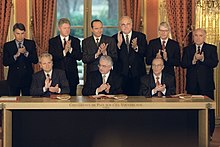
Bill Clinton (third from left) together with international heads of state at the signing of the Dayton Treaty

Burning Vietcong camp in My Tho, Vietnam
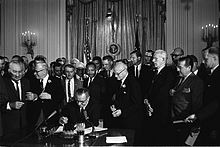
President Johnson at the signing of the Civil Rights Act of 1964
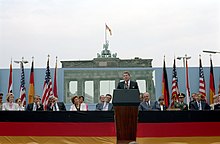
Ronald Reagan gives a speech in Berlin in 1987 with an appeal to Mikhail Gorbachev: "Tear down this wall!"; four years before the end of the Cold War.

Senator Joseph McCarthy
| Crowds outside Wall Street on Black Thursday | A broken down car of a Missouri family fleeing the Dust Bowl and the global economic crisis to California. |

The Battle of Gettysburg 1863 during the War of Secession
.svg.png)
One of the flags of the independence movement of 1775
,_by_John_Trumbull.jpg)
The Declaration of Independence is presented to the Continental Congress. Painting by John Trumbull, 1819
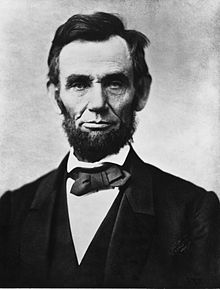
Abraham Lincoln, 16th President of the United States

The thirteen colonies, independent since 1783, and the further territorial expansion of the United States towards the West
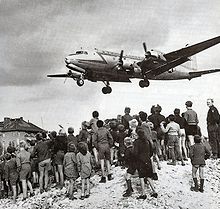
Berliners watch a sultana bomber land at Tempelhof Airport (1948). Photograph by Henry Ries.

George Washington was the first President of the United States.
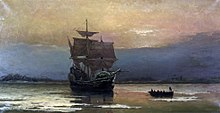
The Mayflower brought English Pilgrims to New England in 1620.
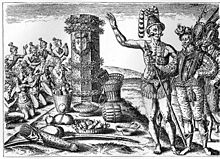
Indians paying tribute to the French in Florida. (Copper engraving, around 1600)
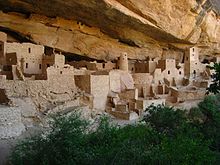
The Cliff Palace, a collection of rock dwellings in Mesa Verde National Park in Colorado, was built by members of the Anasazi tribes in 1190 A.D.
→ Main article: Politicalsystem of the United States
The United States is a presidential federal state with a bicameral system. The form of government is based on a representative democracy.
Powers at the federal level
The United States has had its second constitution since its founding, following the Articles of Confederation. It provides for a presidential, federal and republican political system that separates the legislative, executive and judicial branches horizontally and the federal level from the states vertically in a comparatively strict manner.
Legislative
According to the constitution, the strongest organ of state at the federal level is the Congress, which exercises legislative power. It is composed of elected representatives from all 50 federal states. Congress, which consists of two chambers, has budgetary sovereignty and the right to initiate legislation. Among other things, Congress has a significant influence on American politics as a result of its budgetary powers. Congress alone has the right to enact federal laws and declare war. Treaties with foreign countries are signed by the president, but require ratification by the second chamber of Congress, the Senate. In the case of important appointments (for example, to cabinet posts or federal judgeships, especially on the Supreme Court), the Senate, after hearing the candidates, has the right to confirm or reject the President's proposal.
Members of the House of Representatives, the first chamber of Congress, are elected for two-year terms. Each representative represents a constituency of his or her state. The number of constituencies is determined by a census taken every ten years. Senators are elected for six-year terms. Their election is staggered, meaning that one third of the Senate is elected every two years. The Constitution provides that the Vice-President presides over the Senate. He has no voting rights, except in the event of a tie.
Before a bill becomes federal law, it must have passed through both the House of Representatives and the Senate. The bill is first introduced in one of the two chambers, considered by one or more committees, amended, rejected in committee or adopted and then debated in one of the two chambers. Once it is adopted in that chamber, it is passed on to the other chamber. Only when both chambers have adopted the same version of the bill is it submitted to the President for assent. The president then has the option of delaying the bill's entry into force. After such a veto, Congress can pass a new bill or finally overrule the President by a two-thirds vote.
Executive
→ Main article: Federal government (United States)
The President, who heads the executive branch, is both head of state and head of government. He is also the commander-in-chief of the armed forces of the United States and, together with the Secretary of Defence, forms the National Command Authority (NCA), to which it is solely incumbent to make the decision on an attack by the United States with nuclear weapons. To do so, both persons must independently agree to the nuclear strike. 46 Since 20 January 2021, the incumbent has been Joe Biden, a Democrat elected on 3 November 2020. The president is represented by the vice president elected with him. In the event of an early termination of the president's term of office, the vice-president takes the president's place in full until the end of the term of office and also presides over the Senate. The current Vice President is the Democrat Kamala Harris.
In the event that the Vice-President is unable to attend or is absent, the Senate appoints a "Pro-Tempore Chairman", a temporary chairman. The members of the first chamber, the House of Representatives, elect their own Speaker, the "Speaker of the House of Representatives(Speaker)". Speaker and Pro-Tempore Chair are members of the strongest party in their chamber. The Speaker has been Nancy Pelosi, a Democrat, since 2019, and the Pro-Tempore Chair has been Chuck Grassley, a Republican Senator.
Judiciary
→ Main article: United States law
See also: Supreme Court of the United States
At the head of the judiciary, which is also federally organised, is the Supreme Court. The Constitution, which came into force in 1787 and whose provisions are enforceable, is of great importance in the political system of the United States. It speaks for the success and stability of this constitution that it has so far only undergone 27 changes ("amendments").
Parties and elections
→ Main article: Presidential election in the United States
→ Main article: Congressional elections in the United States
In the United States, a two-party system has formed, favoured by relative majority voting. These parties have been the Democrats and the Republicans since the mid-19th century. The Democrats are currently the largest party with 72 million registered supporters (42.6%), followed by the Republicans with 55 million supporters (32.5%) and 42 million voters registered without party preference (24.9%). In this context, both parties, which are not assigned a constitutional role, can at best be subjected to rudimentary schematisation, since they already represent intra-party coalitions of different currents.
Issue-specific political currents and interest groups are more likely to try to influence MPs and other leaders of both major parties than to form independent parties. Examples include the American Civil Liberties Union, the fundamental Christian Moral Majority and the Tea Party movement.
Smaller parties such as the Green Party, the Libertarian Party or the Communist Party of the USA are insignificant, although in presidential elections the votes cast for the Green candidate can sometimes be perceived as a - possibly decisive - disadvantage for the Democratic candidate. A major exponent of the Green Party of the United States for a time in the 1990s was Ralph Nader, who entered the 1996 presidential campaign as the party's candidate and is well known at home and abroad as a "consumer advocate".
→ Main article: History of women's suffrage in the USA
At the state level, women's suffrage was achieved at different times. In New Jersey, wealthy women had already had the right to vote since 1776 and voted from 1787. When universal male suffrage was introduced there, women lost the right to vote. Bringing up the rear in 1918 were Oklahoma, Michigan, South Dakota and Texas (women's suffrage in primary elections). In some states, even after 1920, restrictions such as literacy tests and poll taxes were used to exclude blacks from voting. At the federal level, the Constitution of 13 September 1788 did not impose any gender restrictions on passive suffrage for the two chambers. However, it was not until 1920, with the enactment of the 19th Amendment to the United States Constitution, that all restrictions on the right to vote based on gender were explicitly prohibited in the USA, giving women full suffrage at all levels. The 1920 American presidential election was the first in which women's suffrage came into play.
Political indices
| Political indices | ||||
| Index name | Index value | Global rank | Interpretation aid | Year |
| Fragile States Index | 38.3 from 120 | 149 from 178 | Stability of the country: very stable | 2020 |
| Democracy Index | 7.92 from 10 | 25 from 167 | Incomplete democracy | 2020 |
| Freedom in the World Index | 86 from 100 | - — | Freedom status: free | 2020 |
| Press freedom ranking | 23.93 from 100 | 44 from 180 | Satisfactory situation for press freedom | 2021 |
| Corruption Perception Index (CPI) | 67 from 100 | 25 from 180 | 0 = very corrupt / 100 = very clean | 2020 |
Federal structures
States
→ Main article: State of the United States
See also: Colonies of the United States
The United States consists of 50 states.
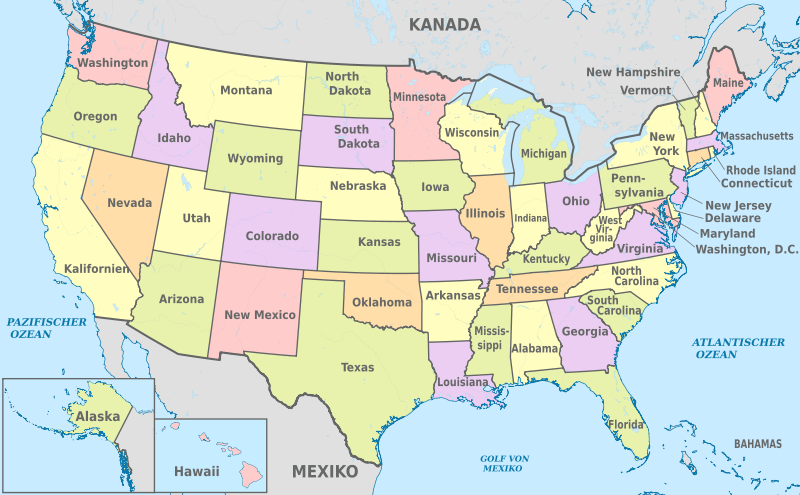
![]()
The heartland comprises 48 of the 50 states plus the District of Columbia (federal district with the capital Washington D.C.), which lie within a common border (so-called "Lower 48"), while Alaska and Hawaii are outside the heartland (Continental United States).
At the founding of the United States, there were thirteen states, which were gradually joined by other territories in the course of westward expansion as far as the Mississippi. After Texas, the wave of annexation skipped over the sparsely populated mountain ranges and continued above all with California and Oregon after the middle of the 19th century. This development was only completed during the First World War. In 1959, the Pacific archipelago of Hawaii as well as Alaska to the northwest, which borders Russia via the 100 km wide Bering Strait, became part of the United States as federal states.
Administrative structure
See also: Administrative unit in the United States
In 2002, there were 87,900 local government units in the United States, including towns, counties, settlements, school districts and other districts, according to the Census and Population Bureau. More than three-quarters of the citizens of the United States live in large cities or their suburbs (List of cities in the United States).
A county is a subdivision of most states and is roughly comparable to a county. In Louisiana they are called "parishes"; in Alaska there are no such administrative units, only statistical subdivisions. In Virginia and Missouri there are also cities that are not assigned to a county. In large cities (e.g. Philadelphia), the boundaries of city and county are sometimes the same; the city of New York even has five counties, each of which is called a "borough". It is not uncommon for towns and even villages to cross a county boundary. County forms of government and their powers vary widely from state to state, sometimes even within a state if the legislature of the state in question has given different forms to choose from. Almost all of them borrow and collect taxes. They have employees, are very often responsible for overseeing elections, and build and maintain roads and bridges (sometimes on behalf of the federal or state government). Social welfare programmes are partly run by them, partly by the townships, which, especially in the Midwest, are not congruent with the municipalities designated with an area of 36 square miles in the 18th century land survey.
A special aspect in some smaller towns, rare and predominantly found in the New England states, is the "town meeting". Once a year - more often if needed - all the registered voters of a town come together in a public meeting and elect officials, discuss local politics and pass laws for the operation of government. As a group, they decide on road construction and improvements, construction of public buildings and facilities, taxes and the town budget. The "town meeting", which has existed for two centuries, is often the purest form of democracy, where governmental power is not delegated but exercised directly and regularly by all citizens. However, the vast majority of citizens only know representative democracy.
External areas
→ Main article: Foreign territories of the United States
In addition to the states and the District of Columbia (the territory of the capital Washington, D.C.), there are external territories with varying degrees of autonomy. The largest external territories are Puerto Rico in the Caribbean and Guam in the Pacific.
Domestic policy
An important role in American domestic politics is played predominantly by moral-ethical issues such as the limits of freedom of expression, the right to abortion, the justification of the death penalty, the political recognition of homosexuality, the rights of minorities or the question of what role religious values should play in public life.
Weapons law
→ Main article: Gun law (United States)
Most states have gun laws that are extremely liberal by international standards. The right to bear arms has traditionally been highly valued in the United States, as it is protected by the Second Amendment of the Constitution ("[...] right to bear arms [...]"). Private individuals can therefore purchase firearms and ammunition without much difficulty and carry the weapons openly. In total, there are more than 200 million privately owned pistols and rifles in the United States.
The existing legal situation is controversial in the United States. Its critics see it as a cause for the high number of 350,000 armed crimes and 11,000 murder victims annually, and especially for the numerous rampages, mainly in schools and colleges, because criminals could arm themselves more easily. Proponents of liberal gun laws such as the National Rifle Association (NRA) deny this connection and point to low murder rates in countries such as Switzerland, Canada or New Zealand, where a disproportionate number of guns are also privately owned. Furthermore, they argue that criminals predominantly come into possession of weapons illegally, which is why private individuals should at least be given the opportunity to defend themselves.
Health policy
→ Main article: United States health system
| Development of life expectancy | |||
| Period | Life expectancy in years | Period | Life expectancy in years |
| 1950–1955 | 68,7 | 1985–1990 | 74,9 |
| 1955–1960 | 69,7 | 1990–1995 | 75,7 |
| 1960–1965 | 70,1 | 1995–2000 | 76,5 |
| 1965–1970 | 70,4 | 2000–2005 | 77,2 |
| 1970–1975 | 71,4 | 2005–2010 | 78,2 |
| 1975–1980 | 73,3 | 2010–2015 | 78,9 |
| 1980–1985 | 74,4 | ||
The health care system in the United States is world-class in some areas - especially in research - but in other areas - especially in general patient and insurance care - it is in a desolate state in some cases. Every year, about 1.8 trillion US dollars are spent on the health system. This is about 17 percent of the total US economic output. Compared to Germany, this is almost twice as much per capita. Around 47 million Americans, about 16 % of the total population, do not have health insurance. - However, this is not exclusively due to income reasons (about one third of the uninsured have a household income of 50,000 dollars or more) or because they are too old and thus at risk of illness (about 40 percent of the uninsured are between 18 and 35 years old). In addition, there is a high number of illegal immigrants who also do not have health insurance. Many of those who are insured have to pay extra for all medical services, others who are in a health maintenance organisation (HMO) have to endure bureaucratic paperwork and long waiting times with limited choice of doctors. In 1993, President Clinton failed in his attempt to introduce a uniform compulsory health insurance. In 2010, under President Obama, legislation was passed to gradually reform the health care system by 2018. The new President Donald Trump, elected at the end of 2016, announced that he would again abolish and replace the health care reform in whole or in part.
The high level of obesity has taken on the character of a national health crisis in the 21st century. According to data from the World Health Organisation, 67.8 per cent of Americans of legal age were overweight in 2014 and 33.7 % of the population of over 300 million were even severely overweight. This is one of the highest rates in the world and costs hundreds of billions of dollars annually.
Life expectancy in the United States was 79.8 years in 2016, ranking 43rd in the world, down 20 places from 1984 and one of the worst in the developed world. Lack of health insurance and obesity are cited as reasons. The life expectancy of the black population is 73.3 years. Added to this are the risks of poverty. For example, in December 2009, 38.97 million people were on food stamps. In 2013, there were 47 million people in 23 million households, or 20% of all US households.
Social policy
→ Main article: Social security (United States)
The United States is a welfare state in which transfer payments are often jointly funded and organised by the federal government and the states. State legislation can have a significant influence on social policy. Basic social protection in old age is provided at the federal level by the public pension insurance Social Security.
Energy and environmental policy
See also: Climate policy#Measures by the USA
The United States has the second largest CO2 emissions in the world after China. Its share of global CO2 emissions is 17.7 per cent (year 2011).
In the Climate Protection Index 2020 (as of December 2019), the USA was ranked 61st, the lowest of all countries surveyed. It performed very poorly in all categories assessed. In particular, the lack of a national climate protection strategy and the withdrawal from the international climate protection agreement under President Trump were criticised.
In the United States, the share of renewable energies is increasing slightly. In 2017, they reached a share of 11 percent in energy consumption and 17 percent in energy production.
In 2002, the government published a strategy to reduce greenhouse gases in the US economy by 18 per cent (by 2012). This should lead to a reduction in CO2 emissions of 160 million tonnes. Internationally, the measures are criticised as completely inadequate. Bill Clinton did have the Kyoto Protocol signed towards the end of his term in office, but it is not binding because it was not ratified by Congress. The emerging countries had not been obliged to reduce greenhouse gas emissions in the treaty. In addition, a strong sense of sovereignty, especially in the Senate, plays an important role.
Environmental disasters and actions by environmentalists, among them former presidential candidate Al Gore, have initiated a change in consciousness. Barack Obama initiated a change of course in climate policy. In December 2012, he declared the fight against climate change as one of the three most important issues for the new term. In his inauguration speech in January 2013, he singled out the fight against climate change and the expansion of renewable energies as a priority for the coming years and announced a focus on renewable energies in which the USA should become a leader instead of ignoring global development.
In the United States, climate change and import dependency on oil are also discussed primarily from the perspective of international security.
Climate protection policy has so far relied primarily on voluntary measures and research funding. Some states (notably California) enforced stricter rules. The most important environmental authority at the federal level is the Environmental Protection Agency (EPA), which environmentalists criticise for its low level of activity.
Foreign and security policy
→ Main article: Foreign policy of the United States
The foreign policy of the United States is based on an attitude that has great similarities with political realism. This is contrasted with an idealism that has remained unbroken and unusually strong since the independence movement, whose origins lie in the anti-European affects of the revolution and in some schools of foreign policy thought give rise to the belief in a historically unique mission of the United States (American Exceptionalism, in German "amerikanische Einzigartigkeit"). Despite frequent tensions between aspiration and practice, this bipolarity of American foreign policy persists because of many similarities. For example, the ideal of the greatest possible freedom of contract in a liberal social and world order converges with the United States' economic dependence on overseas trade in its advocacy of free trade.
The real-political interests that the official foreign policy of the United States advocates include, in addition to guaranteeing the worldwide security of its citizens and their dependents, the safeguarding of the United States against external attacks and the constant availability of resources that are of central importance to the country's economy. The idealistic interests that are to guide and justify the long-term actions of the United States consist in the advocacy of human rights, the democratic plebiscitary political shaping of sovereign states by their state peoples and a global market economy system.
In its concrete implementation, foreign policy has increasingly evolved from a passive to a formative role. From its foundation until the Second World War, isolationism predominated, i.e. the deliberate neglect of foreign policy in favour of domestic development and cultivation. If this attitude was expressed most strongly in the country's consolidation phase through the Monroe Doctrine, it increasingly loosened in the age of imperialism up to the First World War, only to be completely discredited by the attack on Pearl Harbor. Immediately, American-style internationalism suddenly gained in importance through the confrontation with the Soviet Union in the Cold War. This was supported by an institutionalist practice, i.e. the establishment of transnational bodies for long-term cooperation with states. This was done either in association with states that represented similar interests in order to strengthen them, or to bridge political differences with states that had opposing interests. The United States is therefore the initiator and co-founder of numerous multinational bodies and organisations, such as the United Nations, the World Trade Organisation (formerly GATT), the World Bank and NATO or the CSCE. At the same time, the policy of the United States since its inception has been to oppose any possible curtailment of its own sovereignty through international agreements. For example, the United States opposes the signing of international climate protection agreements such as the Kyoto Protocol, support for the International Criminal Court and the Ottawa Convention against the Proliferation of Anti-Personnel Mines. Bilateral trade and defence agreements therefore play a much greater role than, for example, for most members of the European Union, despite their universal claim.
Depending on the domestic global focus, the United States prioritises individual foreign policy efforts and adds them up to morally reinforced concepts. These include the War on Terrorism, the War on Drugs and the War on Poverty.
Due to the predominant political, economic and military position of the United States and its increasingly offensive influence on the politics and economy of the entire international community, the country's foreign policy polarises like no other. Criticism is directed above all at the numerous military interventions abroad, the worldwide social upheavals caused by globalisation, and human rights violations in dealing with suspected terrorists and prisoners of war.
Allies of the United States can be found, among others, in NATO. In addition, they maintain close diplomatic and strategic relations with nations outside NATO (see Major non-NATO ally). Some of these are democratically and market-economy oriented countries that see themselves existentially threatened by neighbouring political actors, such as Israel, South Korea or Taiwan; some are countries closely allied through historical events, such as Japan, the Philippines and Australia; and some are primarily strategically important partners, such as Pakistan, Jordan and Kuwait. The United States maintains by far the strongest relations with the United Kingdom, the only country with which it cooperates even in such sensitive areas as nuclear technology. According to its own figures, the United States operates 766 military bases of various sizes in 40 countries worldwide (of which 293 are in Germany, 111 in Japan and 105 in South Korea; as of 2006).
Military
→ Main article: Armed Forces of the United States
The armed forces of the United States are the most costly and, in numbers, the second largest military in the world (after the Chinese People's Liberation Army). They are globally positioned; current army doctrine stipulates that the United States must be able to simultaneously fight two regional wars victoriously worldwide. The armed forces are increasingly exposed to asymmetric warfare. This development has occurred in their history, especially from the Vietnam War onwards.
In the United States, the president is the commander-in-chief of the national armed forces and appoints their chairmen, the Secretary of Defence and the Joint Chiefs of Staff. The Department of Defence administers the armed forces, which are divided into the Army (about 561,000 soldiers), the Air Force (about 336,000 soldiers), the Navy (about 330,000 soldiers) and the Marine Corps (about 202,000 soldiers), totalling about 1,430,000 soldiers as of 30 April 2011.
The Coast Guard (about 44,000 men) is a civilian institution that is subordinate to the Department of Homeland Security in peacetime and may be subordinate to the United States Department of the Navy in wartime. It has relatively limited military capabilities. In addition, each state maintains National Guard units. These are militia units that normally report to the governor of the respective state, but can be deployed abroad as part of the army at the direction of the president. Military service is voluntary, although in wartime conscription may be issued through the Selective Service System.
Furthermore, the federal states are authorised to establish their own military units, the so-called State Guards, referred to as State Guard, State Military, State Defence Force, State Militia or State Military Reserve, depending on the state. These differ from the National Guards in that they cannot be placed under federal command and the states are not obliged to establish them. Therefore, only 22 states and the territory of Puerto Rico currently maintain such military units.
The United States was the world's first nuclear power and, with the atomic bombs dropped on Hiroshima and Nagasaki, was the only state to use nuclear weapons in a war to date. American defence companies are world leaders, especially in aeronautics. In terms of army weapons, US defence companies are losing ground. The United States' military expenditure amounted to around 596 billion US dollars in 2015. This made the United States the country with the highest military expenditure worldwide in 2015. The military expenditure of the United States is almost three times as high as that of China, which is in second place worldwide.
Military developments, especially of a technological nature, are groundbreaking, especially for the United States' allies in NATO. The state-critical tendency that led to the United States military being small in size throughout its history until the United States entered World War II was increasingly eclipsed during the Cold War by many Americans' fear of communism. As a result, the original idea that the military, as the ultimate instrument of state power, posed a threat to citizens was on the wane.
Since the Second World War, supporting friendly nations through major arms deliveries has proven to be a tried and tested means of passive support in times of crisis for the United States. In the Second World War, the Lend-Lease Act made it possible to supply heavy equipment first to Great Britain and the Commonwealth, and later also to the Soviet Union, which shifted the military balance strongly to the disadvantage of the Axis powers. After the Second World War, for example, Persia was helped to supremacy in the Middle East by the supply of modern aircraft, tanks and missiles. When the overthrow of the Shah regime turned friendship with the United States into enmity, the United States switched to supplying Iraq under Saddam Hussein in the 1980s, who offered himself to the West as an opponent of Iran and led the First Gulf War against Iran.
Police
→ Main article: Police (United States)
See also: United States prison system, Death penalty in the United States
Human rights
→ Main article: Human rights in the United States
See also: Torture#USA
By ratifying various conventions, the United States has assumed certain obligations, including the review of the human rights situation in the United States by the UN Human Rights Council. Nevertheless, criticism of the human rights situation in the United States is frequently voiced, especially by private non-governmental organisations such as Amnesty International and Human Rights Watch: Human Rights Watch, for example, criticises in particular the death penalty, which is still practised today, mistreatment by the police, judiciary or military, the overcrowded prisons and in some cases inhumane prison conditions. These partly violate the UN Convention against Torture and other international standards of humane treatment. For example, prisoners often have to spend 23 hours in solitary confinement, the lights are on 24 hours a day, and physical exercise is only allowed four hours a week in a small cell.
This is also where aspects of the criticism of racial discrimination as a violation of human rights come in: With a population share of 13 per cent, a rate of 43 per cent African Americans among those convicted by law is very high. In some states in the United States, one in ten African Americans is incarcerated. The prison population in the United States is generally high: in 2001, 2.1 million Americans were in prison, one in 146 adults. By 2011, that number had risen further to 2.4 million. In addition, at least 47 people died in police attacks in 2009 through the use of stun guns (cf. Amnesty International Report 2010, USA).
Internationally, arrests and police or intelligence actions related to 11 September 2001 have also caused a stir. Following the attack on the World Trade Center and the Pentagon, 1,200 foreign nationals were arrested in the United States and detained for extended periods of time for various reasons. Information about the identity of those arrested, the place of their detention and whether they received legal assistance has not been made public by the Department of Justice. The principle of presumption of innocence was not applied in these cases. This was made possible by the USA PATRIOT Act of 25 October 2001, which brought about a restriction of American civil rights on a larger scale. Not only does the law allow police to wiretap and monitor people without a warrant, it also authorises house searches, deportations and the collection of private data without evidence of a crime. The most far-reaching change, however, is the power of the foreign intelligence service CIA to operate domestically from now on - this was previously strictly separated and only allowed to the federal police FBI. The Military Commissions Act also makes it possible to declare hostile persons as so-called "unlawful enemy combatants", which means that these persons can be sentenced by military courts (including on the basis of confessions obtained under torture) without being given the opportunity to invoke the Geneva Conventions applicable to combatants or to complain about their treatment.
The situation of the prisoners in the American detention centre at Guantanamo Bay Naval Base in Cuba has also been sharply criticised from many sides. Over 600 people from 42 nations are being held there, most of them illegally, including a number of children under the age of 16. Their status remains unclear, they are neither prisoners of war nor criminals and are in what the United States considers a lawless space, which means that the laws that apply in the United States do not apply there. This, however, is not recognised internationally and is considered contrary to international law. However, this allowed the military to carry out measures contrary to international law, such as torture or trials without a right of defence. A legal examination of the torture practices systematically carried out under the former Bush administration in secret CIA detention centres (black sites), such as simulated drowning ("waterboarding") of people abducted from other countries, some of them unlawfully, has not yet taken place. The conditions of detention in such military detention centres are often inhumane: there are reports of physical abuse, use of force and torture (e.g. dislocation of limbs, beatings on the testicles, or total deprivation of sleep and food), as well as humiliation of the dignity and religion of the detainees (e.g. by smearing the person with excrement, or desecration of the Koran).
The UN Special Rapporteur on extralegal executions expressed concern that between 2003 and May 2009, there were "far more than the officially reported 74 deaths among migrants in the custody of immigration and customs authorities".
In the course of the Iraq war, American soldiers carried out a series of massacres of civilians. Well-known examples are the Haditha massacre, the Maqarr adh-Dhib massacre, the Baghdad airstrikes of 12 July 2007, the Mahmudiyya massacre and the Abu Ghuraib torture scandal. In Afghanistan, too, there have been repeated massacres of civilians by members of the US armed forces since 2001 (including the Kill Team killings in Afghanistan). In its war on terror, the United States increasingly relies on combat drone operations in other countries (for example Yemen, Pakistan), thereby violating international law and the human right to integrity. Between 2004 and 2009, the Bureau for Investigative Journalism recorded 52 drone attacks. According to the Bureau for Investigative Journalism's research, between 2440 and 3113 people were killed between the beginning of the attacks and May 2012. The number of civilians among them is given as 479 to 821, including 174 children. In addition, there are about 1200 injured.
.jpg)
Black Lives Matter protest against police brutality in Minneapolis, Minnesota.

Worldwide military relations and presence of the United States

The aircraft carrier battle groups of the Kitty Hawk, Ronald Reagan and Abraham Lincoln with fighter aircraft of the Marine Corps, Navy and Air Force
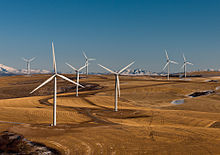
Power County Wind Farm in Idaho
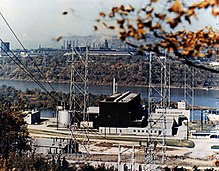
The first commercial nuclear power plant in Shippingport

Life expectancy by county 2018
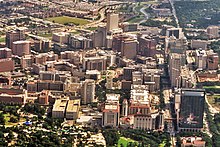
The Texas Medical Center, the largest medical building complex on earth

Signing of the Patient Protection and Affordable Care Act
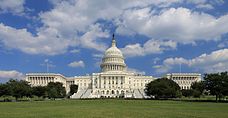
The Capitol is the seat of the United States Congress.

Map of the United States with State and County Boundaries
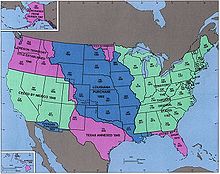
Federal States by year of accession to the Federal Constitution
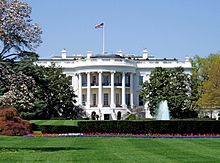
The White House, a building in Washington, D.C., is the official residence of the President of the United States.
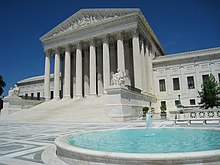
Supreme Court in Washington, D.C.
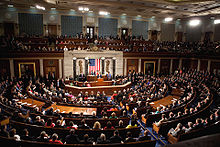
The 44th President of the United States, Barack Obama, addresses Congress (9 September 2009)
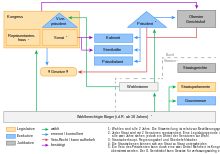
Political system of the United States
.jpg)
Protest against the war in Yemen, New York City, 2017
.jpg)
The United Nations Headquarters in New York City

The Harry S. Truman Building is home to the United States Department of State

The Pentagon near Washington is the headquarters of the US Department of Defence.

The U.S. Army and Marine Corps together have 5970 M1 Abrams main battle tanks.
Economy
→ Main article: Economy of the United States
Economic situation
| Economic indicators | ||
| Nominal GDP | 22.048 trillion $ (Q1 2021) | |
| Real GDP growth | 6,4 % (Q1 2021) | |
| −3,5 % (2020) | ||
| Consumer Price Index Inflation | 2.6 % (March 2021) | |
| Employment rate | 57.8 % (March 2021) | |
| Unemployment rate | 6.0 % (March 2021) | |
| Labour force potential | 61.5 % (March 2021) | |
| Poverty rate | 10,5 % (2019) | |
| National debt | 27.747 trillion $ (Q4 2020) | |
| Assets of private households | 130.4 trillion $ (Q4 2020) | |
The United States had a gross domestic product (GDP) of 21.4 trillion US dollars in 2020, making it the largest economy in the world. At 57,324 US dollars, it has the eighth-highest GDP per capita in the world. The service sector accounted for about 77.6% of real GDP in 2012, of which about one-third was in banking, insurance and real estate. Manufacturing contributed about 20.8 % and agriculture 1.6 %. The structure of the economy is strongly oriented towards consumption and services. In 2015, just under one-third of global consumer spending was made in the US. The consumer bias leads to a low savings rate of public budgets.
The economy grew by 2.3 % in 2017, the inflation rate was 2.1 %. The unemployment rate averaged around 5.3 % in 2015 and fell further to 4.1 % in October 2017. The "hidden unemployment rate", which includes workers who have given up looking for a job or are underemployed, was 8.6 % in June 2017; at the height of the financial crisis it had been as high as 17 %.
Since Ronald Reagan's presidency, state intervention in economic processes has been drastically reduced (see Reaganomics). Some sectors of the economy are subject to oversight by a regulatory agency; for example, the states oversee electricity supply through a Public Utility Commission.
The Federal Reserve System ("Fed"), which has been in existence since 1913 and has taken over the tasks of a state central bank, has increased considerably since the financial crisis in 2007. Until then, it only intervened in economic activity by controlling the money supply or the level of key interest rates; since then, it has also acted as a guarantor and lender outside the banking system. In 2014, it bought $55 billion of government securities per month and holds 32.5% of all ten-year US government bonds. The Fed's long-time chairman from 1987 was Alan Greenspan, who was succeeded by Ben Bernanke in 2006, Janet Yellen in 2014 and Jerome Powell on 5 February 2018.
In 2016, the USA was the world's largest sales market for imported goods and the second largest export nation on earth after China. The trade balance of the USA showed a deficit of 505 billion US dollars in 2014: The export volume for goods and services amounted to 2,345.4 billion US dollars in 2014, while imports of goods and services totalled 2,850.5 billion US dollars in the same period. Both export and import volumes grew compared to the previous year. The main consumer countries for US goods in 2014 were Canada, Mexico, China, Japan, Great Britain and Germany.
The median annual gross income of American households was 43,389 US dollars; about 16 % of all households had a gross income of more than 100,000 US dollars. The top 20% of all households earned more than 88,030 US dollars gross per year, the bottom fifth less than 18,500.
Education and ethnicity had a strong influence on income. While the median gross household income in 2006 was US$57,518 for Asian households, it was US$30,134 for black ones. The same median was US$25,900 for a person with a high school diploma, and US$81,400 for those with an academic degree.
The poverty line in 2006 was set at an annual income of 20,614 US dollars (15,860 euros) for a family of four and 10,294 US dollars (7920 euros) for a single person. 36.46 million (≈ 15 % of the population) lived below this threshold in 2005.
The minimum wage was US$7.25 per hour until 2014, with numerous variations in the states. President Obama raised the minimum wage from US$7.25 to US$10.10 by decree on 1 January 2015 for workers whose employers work for the government on a contract basis.
According to a Credit Suisse study, total household wealth (property less debt) amounted to 93.6 trillion US dollars in 2017. American households thus own just under a third of the world's wealth. A total of 6.4 % of adult Americans were wealth millionaires. In the first quarter of 2018, household wealth exceeded the 100 trillion US dollar mark for the first time.
Key figures
In the Global Competitiveness Index, which measures a country's competitiveness, the USA ranks second out of 137 countries (as of 2017-2018). In the Economic Freedom Index, the country ranked 17th out of 180 countries in 2017.
| Change in gross domestic product (GDP), real World Bank | |||||||||||||||
| Year | 2006 | 2007 | 2008 | 2009 | 2010 | 2011 | 2012 | 2013 | 2014 | 2015 | 2016 | 2017 | 2018 | 2019 | 2020 |
| Change in % yoy | 2,9 | 1,9 | −0,1 | −2,5 | 2,6 | 1,6 | 2,3 | 1,8 | 2,5 | 2,9 | 1,6 | 2,2 | 2,9 | 2,2 | −3,5 |
| GDP development (nominal), World Bank | |||||||||
| absolute (in billion USD) | per inhabitant (in USD thousand) | ||||||||
| Year | 2015 | 2016 | 2017 | 2018 | Year | 2015 | 2016 | 2017 | 2018 |
| GDP in $ billion | 18.219 | 18.707 | 19.485 | 20.494 | GDP per capita (in $ thousand) | 56,4 | 57,6 | 59,5 | 62,6 |
| Development of foreign trade | ||||||
| in billions of US dollars and its change compared to the previous year in per cent | ||||||
| 2016 | 2017 | 2018 | ||||
| USD bn | % yoy | USD bn | % yoy | USD bn | % yoy. | |
| Import | 2.187,6 | −2,7 | 2.342,0 | 7,7 | 2.542,7 | 8,6 |
| Export | 1.451,0 | −3,5 | 1.546,3 | 6,6 | 1.664,1 | 7,6 |
| Balance | −736,6 | −795,7 | −878,7 | |||
| Main trading partners of the United States (2018) | |||
| Export (in percent) to | Import (in percent) from | ||
| Canada | 18,0 | China People's Republic of | 21,2 |
| Mexico | 15,9 | Mexico | 13,6 |
| China People's Republic of | 7,2 | Canada | 12,5 |
| Japan Japan | 4,5 | Japan Japan | 5,6 |
| United Kingdom | 4,0 | Germany | 5,0 |
| Germany | 3,5 | Korea Sud | 2,9 |
| Korea Sud | 3,4 | United Kingdom | 2,4 |
| other countries | 43,5 | other countries | 36,8 |
State budget
→ Main article: Budget of the United States
→ Main article: Fiscal equalisation (USA)
In 2016, the national budget comprised expenditures of 3.89 trillion US dollars, compared to revenues of 3.36 trillion US dollars. This results in a budget deficit of 2.8 % of GDP. The deficit amounted to 530 billion dollars. The USA has thus been able to make significant progress in budget consolidation in recent years. For 2017 to 2019, an annual deficit of around 2.9 per cent of GDP is expected. In 2020, the deficit was 3.1 trillion US dollars, a new record.
The national debt of the United States at the beginning of January 2015 was 18.08 trillion US dollars or 104 % of GDP. Local debt, according to the US Debt Clock, totalled US$ 1.87 trillion in January 2015, and the debt of the 50 states totalled about US$ 1.19 trillion. As of August 2014, 34.4% of state debt was allocated to foreign creditors, 65.6% to domestic creditors. According to the US Treasury, China holds $1.27 trillion worth of US government bonds at the end of 2013, making it the largest foreign creditor to the United States, followed by Japan with $1.18 trillion and Belgium with $256 billion.
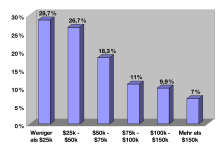
Percentage of households in the respective income groups.
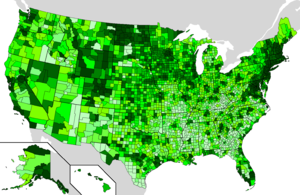
Per capita income by county (2016)
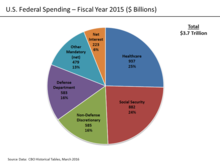
Federal budget expenditure for the 2015 fiscal year
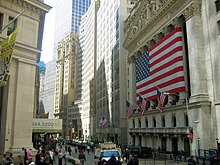
The New York Stock Exchange on Wall Street is the world's largest stock exchange in terms of the market capitalisation of the companies listed on it.
See also
![]()
Portal: United States - Pictures, articles and more about the United States
- Relations between Latin America and the United States
- Relations between the European Union and the United States
- Americanisation
- Anti-Americanism
- American Studies, interdisciplinary field of science dealing with the history, politics, society, culture and language of the United States.
Search within the encyclopedia
